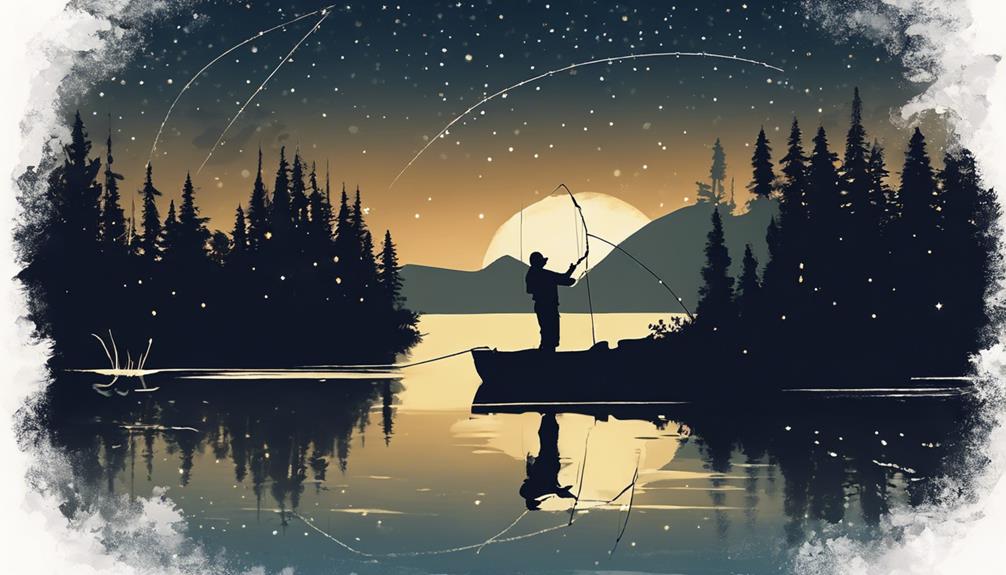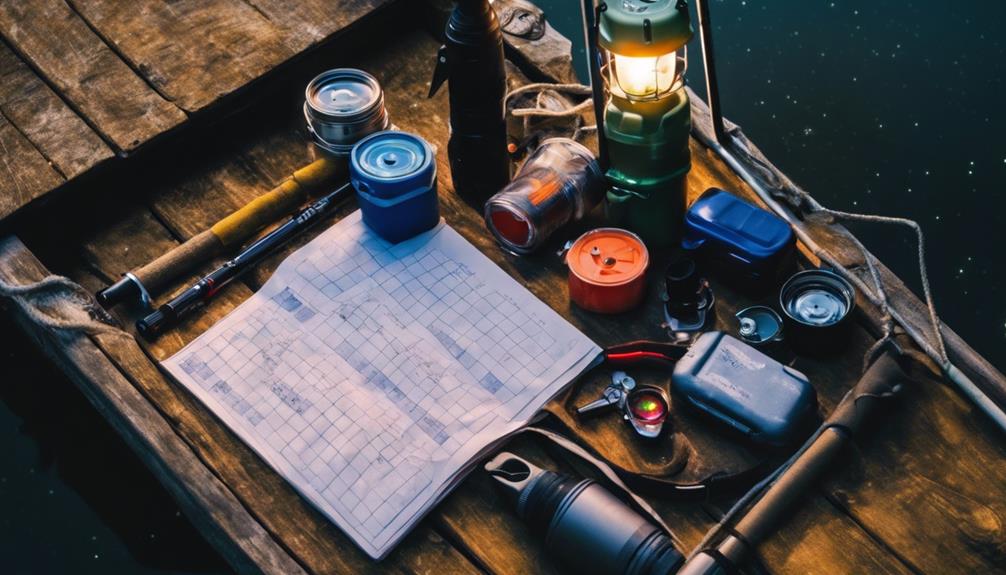When night pike fishing, aim for low light hours around sunrise and sunset. Pay attention to moon phases, favoring new moons over full. Use light sources like headlamps for visibility. Maintain gear and consider upgrading for better control. Opt for flashy lures and topwater baits to attract pike. Understand pike behavior—active predators near structures. Explore varied depths and structures for optimal spots. Factor in weather conditions for increased success. Lastly, prioritize safety with proper attire and precautions. Following these tips can boost your chances of a fruitful night pike fishing adventure.
Best Time to Fish at Night
When targeting pike at night, the best time to fish is typically during the hours of low light just before sunrise and after sunset. Moon phases play a crucial role in night fishing success. During a full moon, the increased light can make pike more cautious, so targeting them during new moon phases when it's darker can lead to better results. Weather conditions also play a significant role. Overcast nights can provide better fishing opportunities as pike are more likely to be active in search of prey.
Light sources are essential when night fishing for pike. Using headlamps or boat lights can help you navigate safely and see your fishing gear. However, avoid shining bright lights directly into the water as it can spook the fish. Fishing partners can also make your night fishing experience more enjoyable and safer. Having someone with you can help in case of emergencies and can make the overall experience more fun.
Remember to pack essential gear like warm clothing, snacks, and drinks when heading out for a night of pike fishing. By targeting pike during the optimal low-light hours, paying attention to moon phases and weather conditions, using appropriate light sources, and considering fishing partners, you can increase your chances of a successful night fishing excursion.
Choosing the Right Fishing Gear
To ensure a successful night pike fishing trip, selecting the right fishing gear is key. When gearing up for a nighttime pike fishing excursion, it's crucial to pay attention to gear maintenance and consider equipment upgrades to enhance your fishing experience.
First and foremost, proper gear maintenance is essential for a smooth fishing trip. Before heading out, check your fishing rods, reels, and lines for any signs of wear and tear. Make sure your reels are well lubricated, and your lines are in good condition to handle the strength of pike. Additionally, don't forget to inspect your hooks and lures for any damage that could potentially cost you a big catch. By keeping your gear well-maintained, you'll avoid any unexpected equipment failures that could ruin your night of fishing.
Furthermore, consider equipment upgrades to optimize your night pike fishing success. Upgrading your fishing rods to ones specifically designed for pike fishing can give you better control and casting distance. Investing in higher quality reels with smooth drag systems can make it easier to handle the powerful runs of pike. Additionally, upgrading your lines to ones with higher strength and durability can prevent break-offs when battling these aggressive predators. By making these equipment upgrades, you'll be better equipped to tackle the challenges of night pike fishing and increase your chances of landing that trophy catch.
Selecting the Ideal Bait
Selecting the right bait plays a crucial role in attracting pike during your nighttime fishing expedition. When it comes to night fishing for pike, choosing the ideal bait can significantly increase your chances of a successful catch. Pike are known for their aggressive behavior, especially during the night when they're more active and on the hunt for prey. Understanding pike behavior is key to selecting the most effective bait that will entice them to strike.
For night pike fishing, it's essential to consider using large, noisy, and flashy lures that can grab the attention of these predatory fish in low light conditions. Topwater lures like buzzbaits or large spinnerbaits are great options as they create commotion on the surface, mimicking the movements of struggling prey. Additionally, soft plastic swimbaits or jerkbaits with rattles can also be successful in attracting pike in the dark.
When selecting live bait for night pike fishing, consider using large minnows or shiners that produce vibrations in the water, drawing in curious pike. Remember to match the size of your bait to the size of the pike you're targeting. Experimenting with different bait types and sizes can help you determine what the pike in your area prefer during nighttime feeding frenzies. By paying attention to bait selection and understanding pike behavior, you can enhance your chances of landing that trophy pike during your next night fishing adventure.
Understanding Pike Behavior
Understanding the behavior patterns of pike is essential for maximizing your success when night fishing for these predatory freshwater species. Pike are known for their aggressive nature and voracious feeding habits, making them a thrilling catch for anglers. These apex predators are most active during low light conditions, such as dawn, dusk, and night, so night fishing can be particularly fruitful.
Pike exhibit unique behavior patterns, often lurking near structures like weed beds, fallen trees, or rocky areas, where they can ambush their prey. They're opportunistic feeders, preying on smaller fish, frogs, insects, and even small mammals. Knowing their feeding habits can help you choose the right bait to attract them effectively. Large spoons, jerkbaits, crankbaits, and live baitfish are popular choices for enticing pike.
When fishing for pike at night, keep in mind that they rely heavily on their sense of sight and lateral line system to detect vibrations in the water. Using noisy lures that create vibrations can grab their attention in low visibility conditions. Additionally, pike are known to follow a strike-and-wait approach, where they strike at their prey and then wait for it to weaken before consuming it. Understanding these behaviors can help you adjust your fishing techniques for a successful night pike fishing session.
Locating Prime Fishing Spots
When searching for prime fishing spots for pike at night, focus on areas with abundant structure and cover where these predatory fish can hide and ambush their prey. Depth exploration is crucial when targeting pike during nighttime. Pike often move to shallower waters to feed under the cover of darkness. Begin by exploring different depths around the water body you're fishing in to locate where the pike might be lurking.
Structure scouting is another key aspect of finding prime pike fishing spots. Look for areas with submerged vegetation, fallen trees, rocky outcrops, or underwater ledges. These structures provide ideal hiding spots for pike as they wait to strike at passing prey. Pay attention to changes in the underwater terrain, as these transitions often attract predatory fish looking for an easy ambush point.
Consider the influence of moonlight on the behavior of pike. During nights with a bright moon, pike might move into darker, shadowed areas for cover while still maintaining access to deeper waters for hunting. Experiment with your fishing spots based on the moon phases to see where the pike are most active. By combining depth exploration with structure scouting, you can increase your chances of locating prime fishing spots for pike at night.
Mastering Night Fishing Techniques
To enhance your night pike fishing success, hone your skills in mastering effective fishing techniques under the cover of darkness. When fishing at night, employing a stealthy approach and utilizing proper lighting techniques are crucial for a fruitful experience. Here are some key tips to help you become a master of night fishing:
- Stealthy Approach: Pike are sensitive to disturbances, especially in the quiet of the night. Move quietly, avoid loud noises, and minimize any unnecessary splashing to prevent scaring off the fish.
- Lighting Techniques: Use dim, preferably red, lights to illuminate your fishing area without startling the pike. Red light is less visible to fish and helps you see clearly without affecting your night vision.
- Moon Phases: Consider fishing during the new moon or full moon phases when natural light is at its peak. This can increase visibility and potentially lead to more successful catches.
- Weather Conditions: Pay attention to weather patterns before heading out. Pike are known to be more active in certain weather conditions. Mild, overcast nights or light rain can sometimes trigger feeding behavior in pike.
Staying Safe While Fishing

For a safe night fishing experience, always prioritize your personal well-being and take necessary precautions to prevent any potential risks or accidents. When venturing out for a night of pike fishing, it's crucial to follow specific safety measures to ensure both your enjoyment and safety.
Night fishing precautions are essential for your well-being. Firstly, make sure to inform someone about your fishing plans, including your expected return time. This simple step can be a lifesaver in case of emergencies. Additionally, always carry a fully charged phone for communication. It's also advisable to wear appropriate clothing, including a life jacket if you're fishing from a boat, to prevent any accidents.
Safety measures should also include carrying a first aid kit. Accidents can happen, and having basic medical supplies can be invaluable. Moreover, investing in a quality headlamp or flashlight is crucial for visibility in the dark. Being able to see clearly not only helps you avoid obstacles but also ensures you can handle your equipment safely.
Lastly, be mindful of your surroundings. Watch out for slippery surfaces near water bodies and be cautious when moving around in the dark. By following these night fishing precautions and safety measures, you can enjoy your pike fishing adventure with peace of mind.
Tips for Handling Your Catch
To ensure the well-being of your catch and maintain its quality, handling your pike properly after the catch is key. Proper handling techniques not only increase the chances of successfully releasing the fish back into the water unharmed but also contribute to preserving the fish population in the long run.
Here are four essential tips for handling your pike catch effectively:
- Minimize Air Exposure: Pike are sensitive to air exposure, which can harm their gills. Keep the fish in the water as much as possible, and only lift it for a quick photo before releasing it back into the water.
- Use Barbless Hooks: Using barbless hooks can make the hook removal process much smoother and less damaging to the fish. This also reduces the risk of injuring yourself during the hook removal.
- Support the Fish Properly: When handling a pike, support its body properly to prevent unnecessary stress on its internal organs. Avoid squeezing the fish too tightly and never hold it vertically by its jaw.
- Avoid Dropping the Fish: Pike have delicate skin that can be easily damaged if they're dropped on hard surfaces. Handle the fish with care and ensure a secure grip to prevent accidental drops.
Frequently Asked Questions
How Can Moon Phases Affect Night Pike Fishing Success?
When night pike fishing, moon phases play a crucial role in your success. Tackling tides under a full moon can lead to increased feeding activity among pike species. This is because pike are more active during well-lit nights.
Exploring equipment designed for low-light conditions, such as headlamps or glow-in-the-dark lures, can give you an edge. So, keep an eye on the moon phases to maximize your night fishing experience.
What Are Common Mistakes to Avoid During Night Pike Fishing?
When night pike fishing, it's important to avoid common mistakes like improper lighting and poor bait presentation.
Proper lighting is crucial as it helps you see your surroundings and detect subtle movements in the water. Ensure your bait presentation is enticing by using the right size and type of bait, and consider the depth and speed of your retrieval.
Is It Better to Fish Alone or With a Partner at Night?
When deciding between going solo vs. bringing a buddy for night fishing, consider safety precautions. Having a partner can provide backup in case of emergencies and make the experience more enjoyable. However, solo fishing allows for more independence and solitude.
Always prioritize safety by informing someone of your plans, bringing necessary equipment, and staying aware of your surroundings. Whether solo or with a buddy, night fishing can be rewarding with proper preparation.
How Do Weather Conditions Impact Night Pike Fishing Outcomes?
When night pike fishing, weather conditions play a crucial role in your success. Temperature fluctuations can affect pike activity levels, with cooler temperatures often leading to more active fish.
Cloud cover can help in reducing visibility, making it easier for you to sneak up on pike. Keep an eye on wind speed and barometric pressure, as these factors can also influence fish behavior.
Being aware of these weather elements can greatly improve your chances of a successful night fishing trip.
Are Artificial Lures or Live Baits More Effective for Night Pike Fishing?
When night pike fishing, you might wonder about lure preference and effectiveness. Artificial lures can attract pike with their flashy designs and movements, but live baits like minnows or frogs offer a natural scent and movement that can entice these fish.
Experiment with both to see what works best in your fishing spot. Remember, pike have their own preferences, so it's key to adapt your tactics to increase your chances of success.
Conclusion
Now that you have learned the top tips for successful night pike fishing, it's time to put your knowledge into action.
Remember to fish during optimal nighttime hours, use the right gear and bait, understand pike behavior, locate prime spots, master fishing techniques, prioritize safety, and handle your catch with care.
With these tips in mind, you'll be well-equipped to have a productive and enjoyable night fishing experience.
Tight lines and happy fishing!



